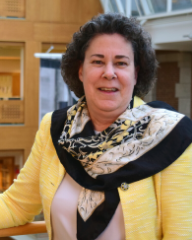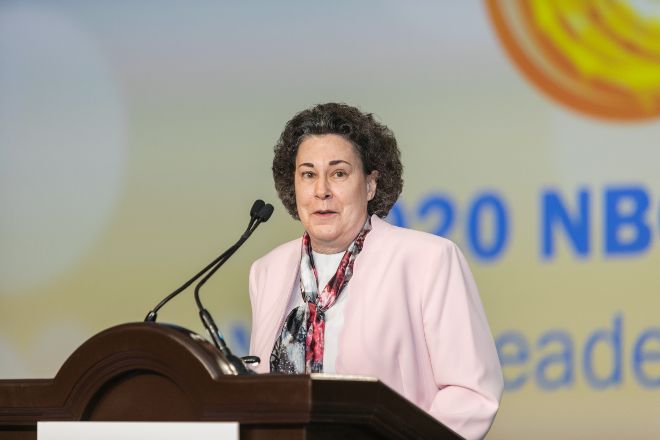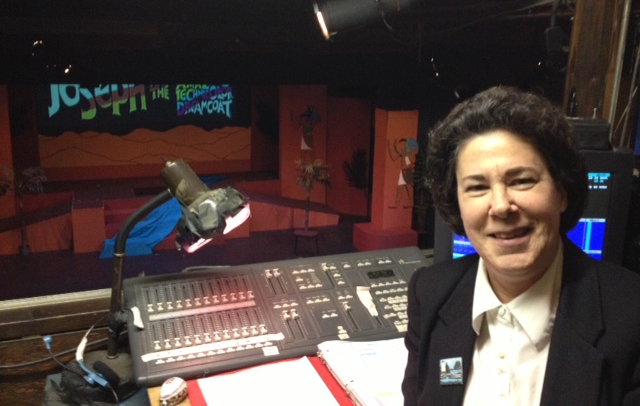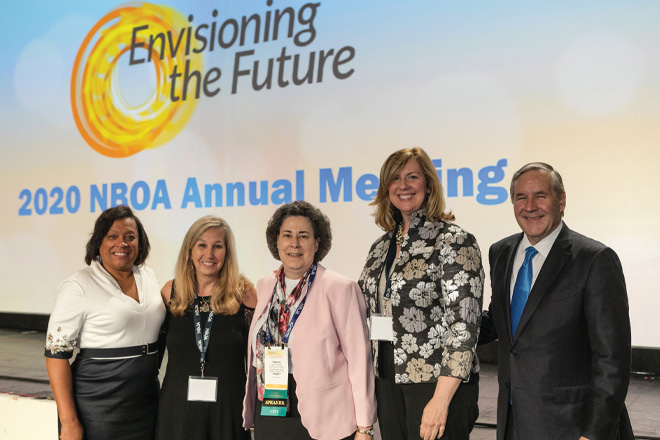Interview by Cecily Garber
Feature image: Valerie Hughes on stage at the 2020 NBOA Annual Meeting. From left to right: Stefanie Corlew, former controller at Hathaway Brown and now director of finance and operations at St. Paul's School, Clearwater, Florida; Joanne Palicka, retired controller at Hathaway Brown; Hughes; Megan Murphy, executive director of the National Coalition of Girls Schools; and Ron Wanglin, Chairman of Bolton & Company and the 2020 recipient of the Sarah Daignault Outstanding Support of Independent Schools Award.
Valerie Hughes is chief financial officer at Hathaway Brown School, an 836-student all-girls day care-grade 12 school in Shaker Heights, Ohio. She is the recipient of the 2020 NBOA Ken White Distinguished Business Officer Award.

Chief Financial Officer
Hathaway Brown School
Net Assets: I understand that before Hathaway Brown you worked at a small private women’s college, Ursuline College. How was that similar to or different from an independent school?
Valerie Hughes: Let me go back a little bit further. This job at Hathaway Brown is only the third job in my entire career. When I got out of college, I worked for the Cleveland YWCA, where I ended up managing not just accounting but also services for the residents, the pool, food service and banquet room rentals. At the time, the YWCA and the YMCA together owned or rented several buildings throughout northeastern Ohio.
I was there for 17 years, and during that time the YMCA started serving women and girls along with men and boys, so the organizations became competitors in the same buildings. When the properties were divvied up, the YWCA got the buildings in the more economically challenged areas — not an unexpected outcome for a women’s organization. The YWCA had also been through five directors in the time I was there. It was almost a hand-to-mouth existence, but I did get a lot of experience working in facilities, literally overseeing the replacement of pool filters and re-tubing of boilers.
I gave you that background because I landed my next job, as vice president for finance and administration at Ursuline, because of my experience with facilities. The hiring committee asked me all these questions about roofs and boilers, and very little about finance. Ursuline’s campus had on-site security and several residence halls, and I unfortunately got firsthand experience handling the aftermath of a major dorm fire and a murder on the Ursuline motherhouse property next door. It was kind of crazy.
After 10 years there, I was called by a recruiter about an opportunity at Hathaway Brown School. I had not planned to leave Ursuline, and I didn’t know anything about the independent school community. I grew up on the west side of Cleveland in a city called Parma that was pretty blue collar. My parents sent me across town to a wonderful all girls Catholic high school, which has unfortunately closed since; I had to take three buses to get to it. In any case, I figured I’d hear what the position was about.
I think the biggest difference was that at the college level you’re dealing with the students directly in terms of payment, rather than the parents.
At Ursuline, even at that time — more than 20 years ago — nearly 80% of the students were on financial aid, and the college was starting to experience some of the same enrollment issues independent schools are now going through. In addition to tuition, I had to deal with federal grants and work study payments. I think the biggest difference was that at the college level you’re dealing with the students directly in terms of payment, rather than the parents.
In the end, HB offered me a salary I couldn’t pass up, and I was excited about the opportunity. When I moved to HB, I thought, this is sort of the same work except that the clients are a bit younger and bit smaller.
Net Assets: So you have worked for a women’s organization, a women’s college and a girls’ school. As a woman with extensive leadership experience in finance and facilities among other areas, do you see yourself as a role model to girls at your school?
Hughes: I definitely enjoy being a mentor to some of our older girls. I’ve helped them develop a manual on financial concepts for middle schoolers, analyze the impact of major online retailers like Amazon on small, local businesses and guide the student investment club, for example.
I think there are probably more females in finance and accounting now than in the past, but still not as many in construction or facilities. We are in the process of planning for major renovations to what we call our classic building, and we made sure there will be females on the construction team visible to the girls. The team is also going to take some girls on as interns.
I wish more women would get into construction and facilities work because it’s a very interesting field. You do have to hold your own with men.
I’ve learned so much from the large construction projects at HB, like building a new 66,000 square foot middle school, as well as an eight-lane aquatic center. We dealt with all kinds of issues, from delays in materials to people picketing us because we didn’t use union workers. I wish more women would get into construction and facilities work because it’s a very interesting field. You do have to hold your own with men.
Net Assets: I hear you’re particularly proud of your work in supporting Hathaway Brown’s Aspire program to provide educational opportunities to underprivileged girls in the Cleveland area. How did the school secure resources for the program?
Hughes: Aspire has been one of the most successful programs we’ve run. It has two components. About 120 middle school girls from outside HB, nominated by advisors at their schools, spend six weeks at HB over the summer in a rigorous academic environment, and they do some additional work over the course of the year. Then before their senior year of high school, about 80 “alumnae” work on their college applications with the Aspire staff. The other component is the college students we bring in as junior teachers and mentors. Some decide they want to pursue teaching, some don’t, but it’s a useful experience either way. I applaud the two middle school faculty members who started the program.
Regarding funding, in the beginning we received a lot of support from area foundations — the Cleveland Foundation, the George Gund Foundation and several smaller ones. They guaranteed funding for 10 years, after which time HB needed to sustain it ourselves. The advancement office worked closely with the Aspire office to solicit donors to endow the program. A few years ago, one of our board members gave a surprising seven-figure gift, and now it’s self-funded.

Net Assets: What advice do you have for business officers looking to stretch themselves beyond their traditional roles in school business and operations?
Hughes: One experience that really helped me stretch myself was being a board member of the National Coalition of Girls Schools. I actually took over the treasurer position from Sarah Daignault [the founding executive director of NBOA]. In my first meeting, I recall thinking to myself, oh my goodness, what have I done? I’m out of my element here because I’m a business officer among all these heads of school.
But I love that organization dearly. It took me out of my comfort zone. For example, we had an all-day retreat about transgender students just as that conversation was coming to the forefront. It helped me think about HB’s stance on transgender students and how we could support their needs.
I don’t have any sage words of wisdom except to say, if there’s an opportunity that comes your way and you don’t think you’re going to be comfortable with it, that might be the time to step in and do it, you know? It certainly helped me.
Net Assets: HB has been part of a growing healthcare consortium among independent schools. Can you tell me how that effort took off and what makes it successful?
Hughes: Well, a few independent schools in Cleveland had formed a small consortium to keep healthcare costs down. The head of Old Trail School at the time, whose previous school in Connecticut had been in a health care consortium, wondered if we could form a larger consortium in Ohio. So a small group of us interviewed several brokers and chose the one we’re still with 15 years later, as the ISBC consortium. For six or seven years the consortium was providing healthcare under a traditional plan, and we were just trying to get enough belly buttons in the group to increase purchasing power and reduce costs.
Then following the Affordable Care Act, we started changing the program’s structure. New regulations prompted us form a self-insured group or captive with the help of our broker. It’s far more complicated than I ever imagined, but I have to say it has benefited us. I compare it to a seven-layer dip. There are all these different layers of insurance, “lasers,” catastrophic insurance and reinsurance.
But the consortium allows us to pool many schools’ resources, protects individual schools if they experience an exceptionally high claim, and if we have a good year, we may get money back. It took us a few years to get to this point, but the captive — now with 58 schools from 12 states — has definitely helped HB keep rate increases low.
Occasionally we bid our business just as HB to make sure we’re considering all options. And every time that analysis has shown that we save considerably with the consortium.
Occasionally we bid our business just as HB to make sure we’re considering all options. And every time that analysis has shown that we save considerably with the consortium. There’s a lot of creativity in terms of how each school can design its own plan.
Net Assets: You’ve also served on a number of accreditation teams over the years. What words do you have for schools preparing to go through the process?
Hughes: We’re actually in our self-study year, so the question is timely. I’ve served on seven or eight different accreditation committees from very small to very large schools. It’s been helpful because I enjoy getting the perspectives of different people in a school, whether they’re faculty or kitchen workers or daycare workers — they all have a voice in how they envision the school and where it’s going. When I did my first accreditation, I felt like I was back in college pulling an all-nighter because they are just so intense. But I’ve truly enjoyed it because I’ve interacted with people I wouldn’t have otherwise, seen schools I might not have seen, and gotten great ideas from those experiences.
As for my own role in HB’s accreditation process, I’m the person who has to look at both the individual trees as well as the forest, and in the accreditation meetings, I need to help different people in the community understand the school’s overall finances. The hardest part is identifying the challenges and clearly articulating how you are going to address them.
Net Assets: What are some challenges and opportunities ahead for independent schools, so far as you see them?
Hughes: One of the challenges we’ve seen is a decline in our enrollment because of economic and demographic reasons — the Cleveland pipeline does not have that many school-aged girls. It’s not like this took us by surprise, but now we’re looking forward and trying to figure out where we go in the future. Whether that means shifting staffing models or something else is not yet clear.
Cleveland is also ground zero for merit aid. It’s turned into strictly a buyer’s market. It’s like a rabbit hole; you just sink farther and farther. We’re fortunate to be financially strong, but we’ve developed a financial sustainability task force to identify and address these issues.
As for opportunities, HB and two other schools have formed a new transportation consortium, which will begin this fall. We all draw from the same suburbs, and the buses were going back and forth with just 10 kids on them in some cases. So we have contracted a company to run nine routes, which is more than the six HB had when doing it alone. It’s going to expand our reach and hopefully bring down transportation costs for all of us. It’s been 18 months in the making. My fingers are crossed that it will work.
Net Assets: You’re known as the “go-to” person in Cleveland for business office questions. Why do you make the time to collaborate?
Hughes: I think what goes around comes around, and I honestly learn a lot more by giving. If I want answers, why shouldn’t I give answers? As for the business officers in Cleveland, I just frankly have a lot of fun with them. We are all like, why reinvent the wheel?

Net Assets: I’ve been told that you’re involved in the Cleveland theater scene. What does that entail?
Hughes: I am in fact a huge theatre fan. I am the treasurer of one of our community theaters here in Cleveland, and I actually run the sound and lights for all its main stage productions. I’ve been doing that since 1992.
We are so fortunate in Cleveland to have a robust arts community. I donate to Playhouse Square — the second largest performing arts center in the country — and subscribe to the Broadway series and other professional shows, but I also appreciate the community theater scene. You get people who are dentists and schoolteachers and flight attendants, and they’re up on stage pouring their hearts out. It’s been a kick for me to be part of the productions. It gets me away from the numbers and into a different community.
But once a year I bring these two worlds together; I take our business office staff, all six of us, out to dinner and to a play, and bring them up to the booth where I do the lights. It’s been a nice bonding experience for them too.
Download a PDF of this article.



